(!)Due to Microsoft's end of support for Internet Explorer 11 on 15/06/2022, this site does not support the recommended environment.
Instead, please kindly use other browsers like Google Chrome, Microsoft Edge or Mozilla Firefox.
50,000 Stock items for Same Day Ship Out.
All Categories
Categories
- Automation Components
A wide variety of standard and configurable components for factory automation engineers in industries such as automotive, semiconductor, packaging, medical and many more.
- Linear Motion
- Rotary Motion
- Connecting Parts
- Rotary Power Transmission
- Motors
- Conveyors & Material Handling
- Locating, Positioning, Jigs & Fixtures
- Inspection
- Sensors, Switches
- Pneumatics, Hydraulics
- Vacuum Components
- Hydraulic Equipment
- Discharging / Painting Devices
- Pipe, Tubes, Hoses & Fittings
- Modules, Units
- Heaters, Temperature Control
- Framing & Support
- Casters, Leveling Mounts, Posts
- Doors, Cabinet Hardware
- Springs, Shock Absorbers
- Adjusting, Fastening, Magnets
- Antivibration, Soundproofing Materials, Safety Products
- Fasteners
A good selection of accessories such as screws, bolts, washers and nuts that you may need for your daily engineering usage.
- Materials
Browse industrial materials ranging from heat insulating plates, sponges, to metal and plastic materials in different sizes to meet your various applications.
- Wiring Components
A wide variety of wiring parts for connecting and protecting control and PC parts including Connectors, Cables, Electric Wires, Crimping Terminals and more.
- LAN Cables / Industrial Network Cables
- Cables by Application
- Cables with Connectors
- RS232 / Personal Computers / AV Cables
- Wires/Cables
- Connectors (General Purpose)
- Crimp Terminals
- Zip Ties
- Cable Glands
- Cable Bushings/Clips/Stickers
- Screws/Spacers
- Cable Accessories
- Tubes
- Protection Tubes
- Ducts/Wiremolds
- General Purpose Tools
- Dedicated Tools
- Soldering Supplies
- Electrical & Controls
A wide variety of controls and PC parts for electrical engineers including Controls, Powers, PC parts and more.
- Cutting Tools
A wide variety of cutting tools for many uses and work materials including End Mills, Drills, Cutters, Reamers, Turning Tools and more.
- Carbide End Mills
- HSS End Mills
- Milling Cutter Inserts/Holders
- Customized Straight Blade End Mills
- Dedicated Cutters
- Turning Tools
- Drill Bits
- Screw-Hole-Related Tools
- Reamers
- Chamfering / Centering Tools
- Fixtures Related to Cutting Tools
- Step Drills
- Hole Saws
- Clean Key Cutters
- Core Drills (Tip Tools)
- Magnetic Drilling Machine Cutters
- Drill Bits for Electric Drilling Machines
- Woodworking Drill Cutters
- Drills for Concrete
- Processing Tools
A wide variety of tools and supplies used in processing including Machine Tools, Measurement Tools, Grinding and Polishing Supplies and more.
- Material Handling & Storage
A wide variety of goods used in shipment, material handling and warehouse including Tape supplies, Stretch film, Truck, Shelf, Crane and more.
- Tape Supplies
- Cushioning Materials
- Stretch Films
- Cardboard
- Plastic Bags
- PP Bands
- Magic Tapes / Tying Belts
- Rubber Bands
- Strings/Ropes
- Cable Ties
- Tags
- Labelers
- Unpacking Cutters
- Packing Support Equipment
- Cloth Sheets for Packing
- Conveyance/Dolly Carts
- Tool Wagons
- Tool Cabinets / Container Racks
- Lifters / Hand Pallets
- Container Pallets
- Storage Supplies
- Shelves/Racks
- Work Benches
- Suspended Clamps/Suspended Belts
- Jack Winches
- Chain Block Cranes
- Bottles/Containers
- Bicycle Storage Area
- Safety & General Supplies
A large variety of goods for every kind of factories and offices including Protection items, Cleaning supplies, sanitations, office supplies and more.
- Lab & Clean Room Supplies
A large variety of items used in R&D and Clean Room including research Equipment, Laboratory Essentials, Analysis Supplies, Clean Environment-Related Equipment and more.
- Press Die Components
Choose from thousands of standard stamping die components including Punch & Die, Gas Springs, Guide Components, Coil Springs and many more.
- Plastic Mold Components
Browse our wide variety of mold components including Ejector Pins, Sleeves, Leader Components, Sprue Bushings and many more.
- Ejector Pins
- Sleeves, Center Pins
- Core Pins
- Sprue bushings, Gates, and other components
- Date Mark Inserts, Recycle Mark Inserts, Pins with Gas Vent
- Undercut, Plates
- Leader Components, Components for Ejector Space
- Mold Opening Controllers
- Cooling or Heating Components
- Accessories, Others
- Components of Large Mold, Die Casting
- Injection Molding Components
Browse our injection molding components including Heating Items, Couplers, Hoses and more.
- Injection Molding Machine Products
- Accessories of Equipment
- Auxiliary Equipment
- Air Nippers
- Air Cylinders
- Air Chuck for Runner
- Chuck Board Components
- Frames
- Suction Components
- Parallel Air Chuck
- Special Air Chuck
- Chemical for Injection Molding
- Mold Maintenance
- Heating Items
- Heat Insulation Sheets
- Couplers, Plugs, One-touch Joints
- Tubes, Hoses, Peripheral Components
Search by Application
Brands
- Scheduled Maintenance Notice: This site will be unavailable due to scheduled maintenance from 7:00 2/3 to 6:00 (SGT) 3/3/2025. We apologize for the inconvenience.
- Notice of End of Sales for Economy Series Pneumatic Equipment Category. More information.
Closed Belts HTD Type
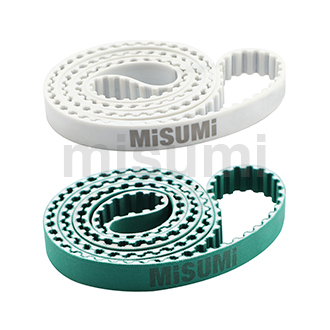
-Closed Belts, HTD Type from MISUMI.
-Adopting cross tapping process, increase the belt contact area at the connection to improve the connection strength.
-Unique steel wire arrangement, it can be assured to avoid cutting the steel wire core during width cutting.
-Cutting equipment is used for standard / both sides cloth lined type. Ensure that complete sealing edge will not produce the side roughness caused by the secondary manual trimming.
Part Number
Configured Part Number is shown.
Economy HTD Closed Belt
- This innovative approach significantly improves connection strength compared to standard joining methods, ensuring reliable power transmission even under high loads.
- A high-strength steel core wire is embedded within the HTD belt, providing exceptional tensile strength and dimensional stability.
- The unique steel wire arrangement ensures that the core remains intact during width cutting.
- For applications requiring minimal noise generation, MISUMI offers HTD Closed Belts with double-sided cloth lining.
- Available in various tooth pitches and belt widths.
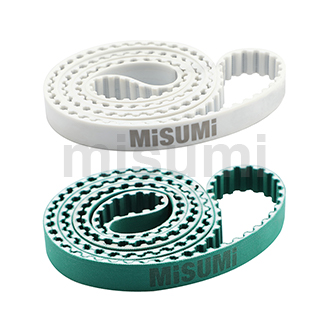

![]()
MISUMI Standard
![]()
Cheaper Price
![]()
Product Variety
![]()
3D CAD Support
Conveyer Product Overview
The closed belt is divided into two types, namely the standard type and the both sides cloth lined type.
There is a both sides cloth lined type suitable for cumulative transmission and noise reduction.
Conveyer Product Features
Feature 2: There is no exposed steel core wire on the side of the closed belt to avoid scratching the workpiece or hurting the operator.
Feature 3: In addition to standard Conveyer belts, there are also both sides cloth lined belts, which can reduce the coefficient of friction between the conveying object and pulley, and lower the noise.
Feature 4: Regular sampling of products is made to ensure a strength in the connection. (See the diagram below)
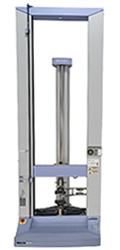
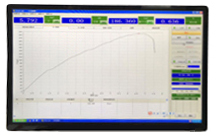
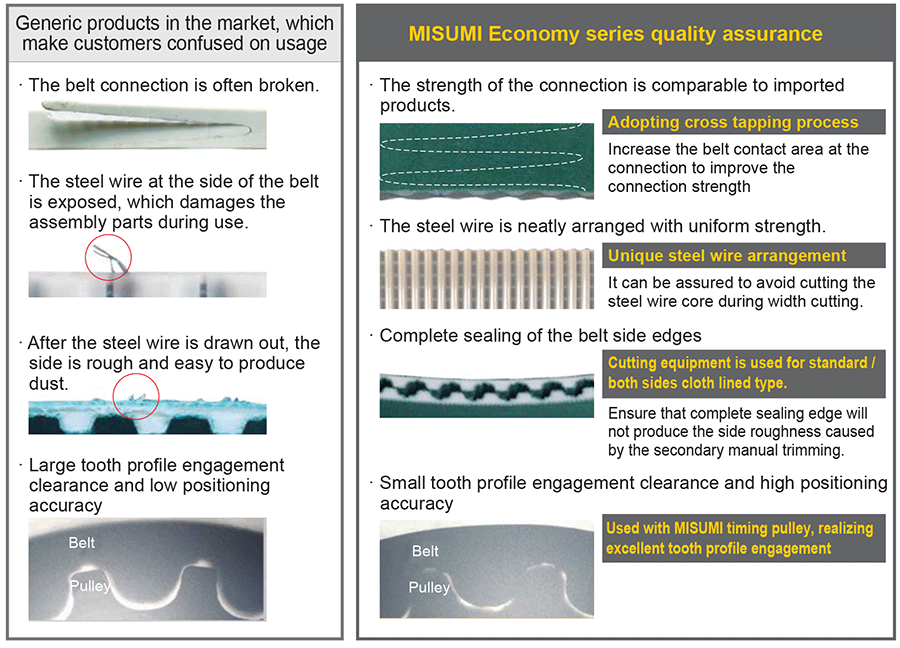
Generic Conveyer products in the market are randomly selected from the market, and products of the same or similar styles are taken as the reference objects.
Dimensional Conveyer Drawing

Specifications Conveyer Overview
| Conveyer Types |  Material Material | ||
| ①Body | ②Core Wire | ③ Canvas | |
| Standard Type | Urethane (White) | Steel wire | - |
| Both Sides Cloth Lined | Nylon Cloth (Green) | ||
■Specification Table
| Belt Type | Pitch (mm) | H | h | i | Unit weight g/m (Width 10mm) |
| H3M | 3 | 2.4 | 1.21 | 1.19 | 27 |
| H5M | 5 | 3.8 | 2.08 | 1.72 | 38 |
| H8M | 8 | 6 | 3.38 | 2.62 | 61 |
 Urethane Conveyer belts may change color over time, but strength, etc. will not be affected.
Urethane Conveyer belts may change color over time, but strength, etc. will not be affected. Conveyer Operating temperature -20℃ to 60℃ (reference value).
Conveyer Operating temperature -20℃ to 60℃ (reference value). Refer to Selection Method of Transmission Timing Toothed Belt on P.1042.
Refer to Selection Method of Transmission Timing Toothed Belt on P.1042. This Conveyer product is not suitable for non-backlash timing pulleys.
This Conveyer product is not suitable for non-backlash timing pulleys. Weight is a theoretical value for reference only, which may be different from that of the actual Conveyer product.
Weight is a theoretical value for reference only, which may be different from that of the actual Conveyer product. Because of the welding process, there will be traces on the surface of the connection, and the allowable tension at the connection is weak, so please pay attention when selecting the type.
Because of the welding process, there will be traces on the surface of the connection, and the allowable tension at the connection is weak, so please pay attention when selecting the type.Example of Conveyer Use
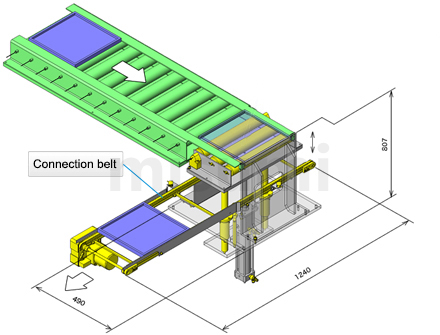
 This provides a reference for the use of urethane Conveyer belts and is not a functional guarantee for actual use.
This provides a reference for the use of urethane Conveyer belts and is not a functional guarantee for actual use.Function Description:
Transfer the workpiece through the motor roller, and use the cylinder mechanism so that the workpiece drop to the lower Conveyer for transmission. The purpose of transmission at different heights is achieved.
For detailed information, click
 here.
here.Conveyer Application Industries
| Conveyer Food | Conveyer Semiconductor | Conveyer Smart phone | ||
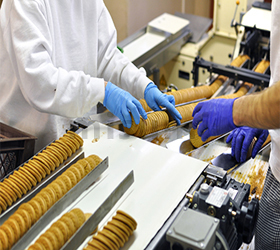 | 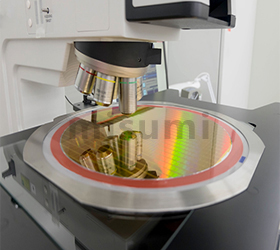 | 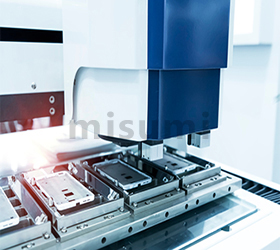 | ||
| Conveyer Medical | Conveyer Electronic & Electrical Appliances | Conveyer Lithium battery | ||
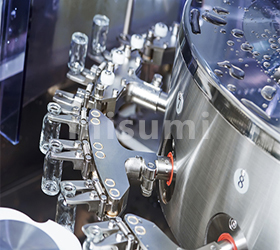 | 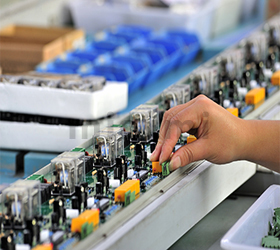 | 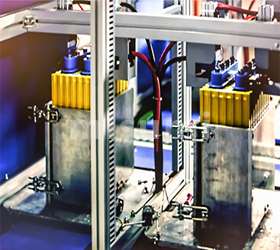 |
Conveyer Precautions
①Avoid sunlight.
② Do not use in direct contact with water, solvent, oil, acid, alkali, UV, ozone, etc.
In particular, do not make oil adhere to the belt, otherwise it will cause the belt to swell, significantly shortening the life of the belt.
③Operating temperature -20℃ to 60℃.
④Do not accumulate in large quantities or forcibly bend.
⑤Do not place it directly on the ground.
⑥Do not make the belt contact with chemicals.
Related Conveyer Documents
 the main causes of premature belt damage and corresponding countermeasures.
the main causes of premature belt damage and corresponding countermeasures.Related Conveyer Products

| Belt Type | Belt Nominal Width | Number of Teeth Lower Limit to Upper Limit | Allowable tension (N) |
| H3M | 060(6mm) | 230~10000 | 70 |
| 090(9mm) | 80 | ||
| 120(12mm) | 90 | ||
| 150(15mm) | 110 | ||
| H5M | 090(9mm) | 140~10000 | 165 |
| 150(15mm) | 230 | ||
| 250(25mm) | 400 | ||
| H8M | 200(20mm) | 88~6250 | 360 |
| 250(25mm) | 450 | ||
| 300(30mm) | 530 | ||
| 400(40mm) | 650 |
 kgf=N×0.101972
kgf=N×0.101972 Total length is (number of teeth × pitch).
Total length is (number of teeth × pitch). The allowable tension is only the permissible value associated with the tensile load.
The allowable tension is only the permissible value associated with the tensile load.■ Comparison Table of Coefficient of Friction (Reference Value)
| Belt type mating parts materials | Toothed Face, Back | |
| Cloth Lined | Standard Type | |
| Stainless Steel | 0.3 | 0.6 |
| Polyamide | 0.2 | 0.3 |
 The values in the table are examples of measured values instead of standard values.
The values in the table are examples of measured values instead of standard values.Part Number
CAD Data download and 3D preview are not available because the part number has not yet been determined.
- *In order to open the CAD Data download and 3D preview screen, the part number must be fixed.
- Please confirm the part number from "Specification / Dimension"on the left side, and then perform the CAD Data Download / 3D Preview operation.
| Part Number |
|---|
| E-LTBJA-H3M060-[230-10000/1] |
| E-LTBJA-H3M090-[230-10000/1] |
| E-LTBJA-H3M120-[230-10000/1] |
| E-LTBJA-H3M150-[230-10000/1] |
| E-LTBJA-H5M090-[140-10000/1] |
| E-LTBJA-H5M150-[140-10000/1] |
| E-LTBJA-H5M250-[140-10000/1] |
| E-LTBJA-H8M200-[88-6250/1] |
| E-LTBJA-H8M250-[88-6250/1] |
| E-LTBJA-H8M300-[88-6250/1] |
| E-LTBJA-H8M400-[88-6250/1] |
| E-LTBRA-H3M060-[230-10000/1] |
| E-LTBRA-H3M090-[230-10000/1] |
| E-LTBRA-H3M120-[230-10000/1] |
| E-LTBRA-H3M150-[230-10000/1] |
| E-LTBRA-H5M090-[140-10000/1] |
| E-LTBRA-H5M150-[140-10000/1] |
| E-LTBRA-H5M250-[140-10000/1] |
| E-LTBRA-H8M200-[88-6250/1] |
| E-LTBRA-H8M250-[88-6250/1] |
| E-LTBRA-H8M300-[88-6250/1] |
| E-LTBRA-H8M400-[88-6250/1] |
| Part Number | Standard Unit Price | Minimum order quantity | Volume Discount | Days to Ship | RoHS | Properties | Belt Type | Number of Teeth | Belt Nominal Width |
|---|---|---|---|---|---|---|---|---|---|
- | 1 Piece(s) | 8 Day(s) | 10 | Standard | H3M | 230 ~ 10000 | 060 | ||
- | 1 Piece(s) | 8 Day(s) | 10 | Standard | H3M | 230 ~ 10000 | 090 | ||
- | 1 Piece(s) | 8 Day(s) | 10 | Standard | H3M | 230 ~ 10000 | 120 | ||
- | 1 Piece(s) | 8 Day(s) | 10 | Standard | H3M | 230 ~ 10000 | 150 | ||
- | 1 Piece(s) | 8 Day(s) | 10 | Standard | H5M | 140 ~ 10000 | 090 | ||
- | 1 Piece(s) | 8 Day(s) | 10 | Standard | H5M | 140 ~ 10000 | 150 | ||
- | 1 Piece(s) | 8 Day(s) | 10 | Standard | H5M | 140 ~ 10000 | 250 | ||
- | 1 Piece(s) | 8 Day(s) | 10 | Standard | H8M | 88 ~ 6250 | 200 | ||
- | 1 Piece(s) | 8 Day(s) | 10 | Standard | H8M | 88 ~ 6250 | 250 | ||
- | 1 Piece(s) | 8 Day(s) | 10 | Standard | H8M | 88 ~ 6250 | 300 | ||
- | 1 Piece(s) | 8 Day(s) | 10 | Standard | H8M | 88 ~ 6250 | 400 | ||
- | 1 Piece(s) | 8 Day(s) | 10 | Both Sides Cloth Lined | H3M | 230 ~ 10000 | 060 | ||
- | 1 Piece(s) | 8 Day(s) | 10 | Both Sides Cloth Lined | H3M | 230 ~ 10000 | 090 | ||
- | 1 Piece(s) | 8 Day(s) | 10 | Both Sides Cloth Lined | H3M | 230 ~ 10000 | 120 | ||
- | 1 Piece(s) | 8 Day(s) | 10 | Both Sides Cloth Lined | H3M | 230 ~ 10000 | 150 | ||
- | 1 Piece(s) | 8 Day(s) | 10 | Both Sides Cloth Lined | H5M | 140 ~ 10000 | 090 | ||
- | 1 Piece(s) | 8 Day(s) | 10 | Both Sides Cloth Lined | H5M | 140 ~ 10000 | 150 | ||
- | 1 Piece(s) | 8 Day(s) | 10 | Both Sides Cloth Lined | H5M | 140 ~ 10000 | 250 | ||
- | 1 Piece(s) | 8 Day(s) | 10 | Both Sides Cloth Lined | H8M | 88 ~ 6250 | 200 | ||
- | 1 Piece(s) | 8 Day(s) | 10 | Both Sides Cloth Lined | H8M | 88 ~ 6250 | 250 | ||
- | 1 Piece(s) | 8 Day(s) | 10 | Both Sides Cloth Lined | H8M | 88 ~ 6250 | 300 | ||
- | 1 Piece(s) | 8 Day(s) | 10 | Both Sides Cloth Lined | H8M | 88 ~ 6250 | 400 |
Loading...
Basic Information
| Belt Material | Polyurethane | Belt Shape Type | Circular Tooth Profile HTD | Belt Shape | Closed End (Weld Jointing) |
|---|---|---|---|---|---|
| Core Wire Material | Steel Cord |
- The specifications and dimensions of some parts may not be fully covered. For exact details, refer to manufacturer catalogs .
Frequently asked question (FAQ)
- Question: The connection belt is processed for jointing at both ends. Is the joint particularly easy to break?
- Answer: The joint of this belt is hot-melt connected, although the strength is lower than that of the body part, there will be no abnormalities such as breakage when used under normal tension. But it is not recommended to bend the joint, or breakage will be caused.
- Question: What kind of belt is better to use under conditions that require high cleanliness?
- Answer: The use of urethane belts is recommended, which has significantly improved dust drop, compared to the rubber belt.
- Question: The timing belt has been broken after use for a very short period of time. Is there a problem with the quality of the belt?
-
Answer:
The timing belt is a standard product, and the same batch of products have very few individual quality problems, please refer to
 Main causes of premature breakage and corresponding countermeasuresto troubleshoot the equipment in use.
Main causes of premature breakage and corresponding countermeasuresto troubleshoot the equipment in use.
- Question: What are the advantages of both sides cloth lined connection belt compared to standard ones?
- Answer: Both sides cloth lined type reduce the coefficient of friction and reduce noise generation.



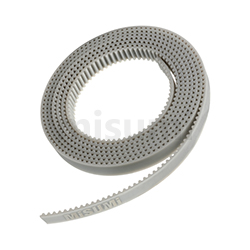
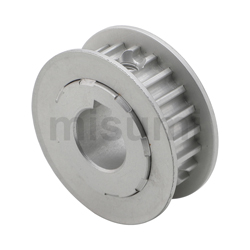
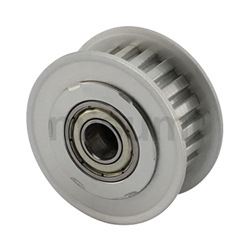
How can we improve?
How can we improve?